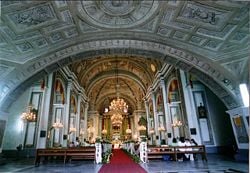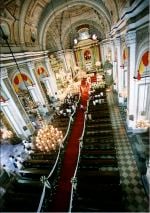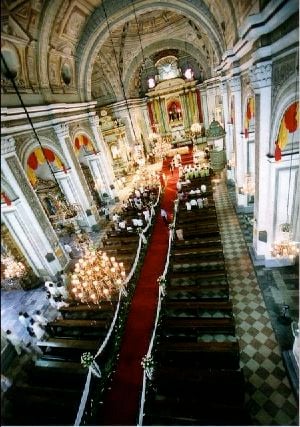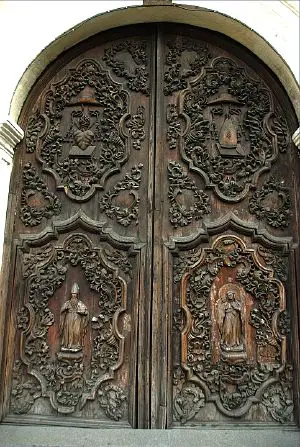Baroque Churches of the Philippines
| Baroque Churches of the Philippines* | |
|---|---|
| UNESCO World Heritage Site | |

| |
| State Party | |
| Type | Cultural |
| Criteria | ii, iv |
| Reference | 677 |
| Region** | Asia-Pacific |
| Inscription history | |
| Inscription | 1993 (17th Session) |
| * Name as inscribed on World Heritage List. ** Region as classified by UNESCO. | |
The Baroque Churches of the Philippines refers to four Spanish-era churches in the Philippines designed by UNESCO World Heritage Site in 1993. On August 15, 1993, UNESCO nominated Church of San Augustin in Manila, Church of La Nuestra Señora de la Asuncion in Santa Maria, Ilocos Sur, Church of San Agustin Church in Paoay, Ilocos Norte, and Church of Santo Tomas de Villanueva Church in Miag-ao, Iloilo.
Description
Those churches have been at the forefront of Philippine history. They have served the Catholic church in the archipelago and as the political backbone of Spanish colonial rule. During the time of Spanish colonial rule, the Church and State worked hand in glove.
The unique architecture of the churches reflected the adaption of Spanish/Latin American architecture to local architecture, including a fusion with Chinese motifs. In addition, the Church's political power manifests from the architecture. Those churches had been subject to attacks by local revolts and rebellions, hence, most have the appearance of a fortress. The blending of religion and defense portrays the manner Spain saw it's situation in the Philippines. Santa Maria Church, located on top of a hill, serving as a citadel during times of crisis, provides the best example. Miag-ao Church also withstood the occasional attacks of Muslims from the south.
The location of the Philippines along the Pacific Ring of Fire called for architecture that could withstand the powerful earthquakes that rock the region. Powerful buttresses and foundations typify those churches. They have survived many powerful earthquakes, winning the name "Earthquake Churches." Although occasionally seriously damaged, they would be rebuilt after an earthquake. Paoay Church has the most imposing of those buttresses, while San Agustin Church, Manila, the only structure in Intramuros to survive World War II, demonstrates the best example of the strength of that architecture. The unique architectural style became known as Earthquake Baroque.
San Agustin Church in Manila
San Agustín Church is a Roman Catholic church under the auspices of The Order of St. Augustine, located inside the historic walled city of Intramuros in Manila. Completed by 1607,[1] it is the oldest church currently standing in the Philippines.[2] No other surviving building in the Philippines has been claimed to pre-date San Agustin Church.
In 1993, San Agustin Church was one of four Philippine churches constructed during during the Spanish colonial period designated by the UNESCO as a World Heritage Site, under the classification "Baroque Churches of the Philippines." It had been named a National Historical Landmark by the Philippine government in 1976.[3]
History
The present structure is actually the third Augustinian church erected on the site.[4] The first San Agustin Church was the first religious structure constructed by the Spaniards on the island of Luzon,[5] Made of bamboo and nipa, it was completed in 1571, but destroyed by fire in December, 1574 during the attempted invasion of Manila by the forces of Limahong.[6][2] A second church made of wood was constructed on the site.[6] This was destroyed in February, 1583, in a fire that started when a candle set ablaze the drapes of the funeral bier during the interment of the Spanish Governor-General Gonzalo Ronquillo de Peñalosa.[2]
The Augustinians decided to rebuild the church using stone, and to construct as well an adjacent monastery. Construction began in 1586, from the design of Juan Macias.[6][5] The structure was built using hewn adobe stones quarried from Meycauayan, Binangonan and San Mateo, Rizal.[3] The work proceeded slowly due to the lack of funds and materials, as well as the relative scarcity of stone artisans.[6] The monastery was operational by 1604, and the church was formally declared as completed on January 19, 1607, and named St. Paul of Manila.[6] Macias, who had died before the completion of the church, was officially acknowledged by the Augustinians as the builder of the edifice.[1]
San Agustin Church was looted by the British forces which occupied Manila in 1762 during the Seven Years' War.[7] It withstood major earthquakes that struck Manila in 1645, 1754, 1852, 1863, and 1880. In 1854, the church was renovated under the supervision of architect Luciano Oliver.[5] On August 18, 1898, the church was the site where Spanish Governor-General Fermin Jaudenes prepared the terms for the surrender of Manila to the United States of America following the Spanish-American War.[4][7]
During the Japanese occupation of the Philippines during World War II, San Agustin Church was turned into a concentration camp for prisoners.[4] During the final days of the Battle of Manila, hundreds of Intramuros residents and clergy were held hostage in the church by Japanese soldiers; many of the hostages would be killed during the three-week long battle.[4] The church itself survived the bombardment of Intramuros by American and Filipino forces with only its roof destroyed, the only one of the seven churches in the walled city to remain standing.[4] The adjacent monastery however was totally destroyed, and would be rebuilt in the 1970s as a museum under the design of architect Angel Nakpil.[3][7]
Features
San Agustín Church measures 67.15 meters long and 24.93 meters wide.[3]. Its elliptical foundation has allowed it to withstand the numerous earthquakes that have destroyed many other Manila churches.[3] It is said that the design was derived from Augustinian churches built in Mexico,[5] and is almost an exact copy of Puebla Cathedral in Puebla, Mexico.[3] The facade is unassuming and even criticized as "lacking grace and charm," but it has notable baroque touches, especially the ornate carvings on its wooden doors.[5] The church courtyard is graced by several granite sculptures of lions, which had been gifted by Chinese converts to Catholicism.[4]
The church interior is in the form of a Latin cross.[3] The church has 14 side chapels and a trompe-l'oeil ceiling painted in 1875 by Italian artists Cesare Alberoni and Giovanni Dibella.[8] Up in the choir loft are hand-carved 17th-century seats of molave, a beautiful tropical hardwood. The church contains the tomb of Spanish conquistadors Miguel López de Legazpi, Juan de Salcedo and Martín de Goiti, as well as several early Spanish Governors-General and archbishops. Their bones are buried in a communal vault near the main altar.[3] The painter Juan Luna, and the statesmen Pedro A. Paterno and Trinidad Pardo de Tavera are among the hundreds of laypersons whose remains are also housed within the church.
San Agustin Church also hosts an image of Our Lady of Consolation (Nuestra Senora de Consolacion y Correa), which was canonically crowned by Manila Archbishop Cardinal Jaime Sin in 2000.[3]
Gallery
- San Agustin 3.JPG
San Agustin Church is a popular venue for weddings.
Nuestra Señora de la Asuncion in Santa Maria, Ilocos Sur
THE CHURCH AND CONVENT
The majestic church, convent and tower built atop a knoll, and with an air of a medieval cathedral-fortress about them, have definitely intrigued many, not the least of whom are present writers.
Like most Philippine churches, legend has been associated with the Santa Maria church. It is said that the original chapel dedicated to the Blessed Virgin was built at a site in the present day barrio of Bulbullala. The statue of the virgin enthroned in that small chapel, so the legend goes, periodically disappeared and was always subsequently found on a guava tree at the site of the present main altar of the church.
Father Mariano Dacanay, the town's Ilokano parish priest from September 1, 1902 to May 27, 1922, has written another variant to this legend which, he assures us, has been obtained from reliable sources. The virgin's statue, Fr. Dacanay relates, was enthroned in another church (not the chapel at Bulbullala) which used to be situated in the present East Elementary School compound at the foot of the present East Elementary school compound at the foot of the present church. It was from here, Fr. Dacanay adds, that the image made its peregrinations to that guava tree on the knoll where the church now stands.
Legends about the virgin have indeed become part of Philippine religious lore, and, if these legends are to be believed, the Virgin herself made known her preference for her permanent home. Almost invatiably a tree is associated with this, and possibly among the most celebrated being that of the Nuestra Senora de Guia who made known her wish by lodging on a pandaan tree on the site where the Ermita church now stands. Viewed againts this backdrop, the Santa Maria legend about the Virgin is, thus, nothing extraordinary.
Be that as it may, a chapel and a tower were built in 1810. The records failed to specify what chapel built at the present site of the church? Or was it actually the small church built on the present site of the East Elementary School? To us, it would seem that the first case was more likely, as no tower, nor even ruins of it, are found below the knoll. Thus, the legend, as recounted by Fr. Dacanay, makes more sense than the other one.
Records also show that the bells for the tower arrived in 1811. In 1822 the convent and church were razed to the ground (again, one is tempted to ask: Whichconvent and which church?). It seems likely that what is meant here were the convent and the church below the knoll.
Nevertheless, the zealous Fr. Bernardino Lago later made Santa Maria a center of his missionary activities for the interior settlements. This may, indeed, explain the (reconstructed?) huge church and convent, and the presence of many side altars in church.. Thus, there seems reason to believe that newly arrived missionaries learned Ilokano psychology and perfected their knowledge of the Ilokano language in Santa Maria before they were sent to neighboring mission posts. Or again, it appears possible that the convent provided a retreat housefor weary Augustinian missionaries from their intense apostolic labors, and for sickly or aging friars.
Fr. Lago converted thousands which necessitated the establishment of the town of Nueva Coveta, the present town of Burgos, in 1831.
In 1863, the church was remodelled, and the sides of the knoll surrounding it, the convent and the tower, reinforced with huge stone boulders kept in place by mortar, a task which must have taken a heavy toll, as it lasted up to 1871. Thus, people began to react against forced labor, and took no pain to hide it.
Obviously, the Santa Marians had not completely forgotten the Diego Silang rebellion in 1762 during the British occupation, and which must have convinced them that the Spaniards were not invincible after all. They also must not have easily forgotten the Sarrat rebellion in 1815, nor the more recent Cavite revolt headed by Camerino in 1869. For while it is true that communication was primitively slow (mails, however, were sent from, and received in Santa Maria in as early as the 1850s), it is equally true that they received news from the outside world somehow or the other.
Sto. Tomas de Villanueva Church in Miag-ao, Iloilo
Miag-ao Church
The Miag-ao Church was built in 1786 by Spanish Augustinian missionaries and was declared as part of the UNESCO World Heritage Site "Baroque Churches of the Philippines" in 1993. On the front facade, which is flanked by two watchtower belfries, one can see the unique blending of Spanish and native influences.
The central feature of the bas-relief facade is a large coconut tree which reaches almost to the apex. While an integral part of the Philippine landscape, the coconut tree is also the subject of lore. According to an old Philippine legend, the coconut tree was the only bequest from a loving mother to her two children, a tree which sustained them for life. On the church's facade the coconut tree appears as the "tree of life" to which St. Christopher carrying the Child Jesus on his shoulder is clinging to. The lesser facades feature the daily life of Miagaowanons during the time. Also depicted are other native flora and fauna, as well as native dress.
The church and its watchtowers were also built to defend the town and its people against raids by the Moros. It therefore has thick walls and, reportedly, secret passages. Indeed stretching along the Iloilo coast are defensive towers, but none that equal the size of the Miag-ao. It is because of this defensive purpose that it is sometimes referred to as the Miag-ao Fortress Church.
UNESCO World Heritage Extension Applications
along with the one in Baclayon, Bohol, World Heritage Site status as part of the Jesuit Churches of the Philippines.
Greater protection

Aside from these four churches, the Philippine National Commission for Culture and the Arts (NCCA) has also designated the conservation and protection of 26 other Spanish-era churches to be of utmost importance. These were registered as National Cultural Treasures.
These churches were given priority status not just due to their historical value, but also based on the geographic representation of various regions across the nation:
- Parish Church of San Agustin in Bacong, Negros Oriental
- Parish Church of the Immaculate Conception in Balayan, Batangas
- Parish Church of Santiago Apostol in Betis Guagua, Pampanga
- Parish Church of Patrocinio de Maria in Boljoon, Cebu2
- Parish Church of Saints Peter and Paul in Calasiao, Pangasinan
- Parish Church of San Vicente de Ferrer in Dupax del Sur, Nueva Vizcaya
- Parish Church of the Immaculate Conception in Guiuan, Eastern Samar1 2
- Parish Church of the Immaculate Conception in Jasaan, Misamis Oriental
- Parish Church of San Juan Bautista in Jimenez, Misamis Occidental
- Parish Church of San Isidro Labrador in Lazi, Siquijor2
- Parish Church of San Pedro and San Pablo in Loboc, Bohol1 2
- Parish Church of Santa Catalina de Alejandria in Luna, La Union
- Parish Church of San Carlos Borromeo in Mahatao, Batanes
- Parish Church of San Guillermo de Aquitania in Magsingal, Ilocos Sur
- Parish Church of San Gregorio Magno in Majayjay, Laguna
- Parish Church of the Assumption of Our Lady in Maragondon, Cavite1
- Parish Church of San Andres in Masinloc, Zambales
- Parish Church of Santa Monica in Panay, Capiz
- Cathedral of San Jose in Romblon, Romblon
- Parish Church of San Raymundo de Peñafort in Rizal, Cagayan
- Parish Church of San Joaquin in San Joaquin, Iloilo
- Parish Church of San Juan Bautista in Tabaco City, Albay
- Parish Church of San Ildefonso in Tanay, Rizal
- Basilica of St. Michael Archangel in Tayabas, Quezon
- Parish Church of Santa Catalina de Alejandria in Tayum, Abra
- Parish Church of San Matias in Tumauini, Isabela
- Parish Church of Santa Maria Magdalena in Kawit, Cavite
- Parich Church of Nuestra Señora Virgen del Rosario de Caracol Rosario, Cavite
Notes
- ↑ 1.0 1.1 Aluit, p. 41
- ↑ 2.0 2.1 2.2 Torres, p. 62
- ↑ 3.0 3.1 3.2 3.3 3.4 3.5 3.6 3.7 3.8 Layug, p. 84
- ↑ 4.0 4.1 4.2 4.3 4.4 4.5 Layug, p. 83
- ↑ 5.0 5.1 5.2 5.3 5.4 Heritage Conservation Society. San Agustin Church (Intramuros, Manila). Retrieved 2008-03-24.
- ↑ 6.0 6.1 6.2 6.3 6.4 Aluit, p. 40
- ↑ 7.0 7.1 7.2 Torres, p. 63
- ↑ Layug, p. 85
ReferencesISBN links support NWE through referral fees
- Layug, Benjamin Locsin (2007). A Tourist Guide to Notable Philippine Churches. Pasig City, Philippines: New Day Publishers, 39-41. ISBN 971-8521-10-0.
- Aluit, Alfonso (1994). By Sword and Fire: The Destruction of Manila in World War II 3 February - 3 March 1945. Philippines: National Commission for Culture and the Arts, 83-85. ISBN 971-8521-10-0.
- Torres, Jose Victor Z. (2005). Ciudad Murada: A Walk Through Historic Intramuros. Manila: Intramuros Administration & Vibal Publishing House, Inc., 62-63. ISBN 971-07-2276-x.
External links
- San Agustin Church Photos
- La Iglesia de San Agustin, Manila
- World Heritage profile
- NCCA's 26 Churches' profile
- Nomination of Jesuit Churches of the Philippines as a World Heritage Site
- Nomination for the Extension of the Baroque Churches World Heritage Site
| |||||||
[[Category:]]
Credits
New World Encyclopedia writers and editors rewrote and completed the Wikipedia article in accordance with New World Encyclopedia standards. This article abides by terms of the Creative Commons CC-by-sa 3.0 License (CC-by-sa), which may be used and disseminated with proper attribution. Credit is due under the terms of this license that can reference both the New World Encyclopedia contributors and the selfless volunteer contributors of the Wikimedia Foundation. To cite this article click here for a list of acceptable citing formats.The history of earlier contributions by wikipedians is accessible to researchers here:
- Baroque_Churches_of_the_Philippines history
- San_Agustin_Church_in_Manila history
- Nuestra_Señora_de_la_Asuncion_in_Santa_Maria,_Ilocos_Sur history
- _Church&oldid=189822604 Miag-ao _Church _Church&action=history history
The history of this article since it was imported to New World Encyclopedia:
Note: Some restrictions may apply to use of individual images which are separately licensed.


